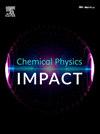碱性燃料电池负载型Au(NiMo)催化剂的高效硼氢化物氧化和氧还原
IF 3.8
Q2 CHEMISTRY, PHYSICAL
引用次数: 0
摘要
在这项研究中,我们使用了一种简单而经济的方法,在钛基板(表示为Au(NiMo)/Ti)上制造了三维镍钼(NiMo)薄层涂层,并稀疏地装饰有金晶体。该催化剂是通过简单的电化学沉积技术(包括动态氢泡模板)将NiMo沉积在Ti表面,然后通过电位移修饰金晶体制备的。研究了所制备的ni /Ti和Au(ni)/Ti催化剂作为碱性燃料电池的潜在材料。Au:Ni:Mo摩尔比为1:52.5:2.4的Au(NiMo)/Ti-3催化剂对硼氢化钠氧化和氧还原的电催化活性显著高于Mo:Ni摩尔比为1:7.8 ~ 1:24.3的NiMo/Ti催化剂,以及Au:Ni:Mo摩尔比为1:50.1:5.5和1:51.2:7.5的Au(NiMo)/Ti-2和Au(NiMo)/Ti-1催化剂。采用制备的Mo:Ni摩尔比为1:24.3的NiMo/Ti-3,以Au(NiMo)/Ti-3催化剂为负极材料,进行了直接碱性NaBH₄-H₂O₂单燃料电池试验。研究发现,在25°C、202 mA cm⁻²电流密度和0.8 V电池电压条件下,以Au(NiMo)/Ti-3作为阳极催化剂,可获得高达162 mW cm⁻²的峰值功率密度。在55°C时获得了最高的金质量比峰值功率密度42.9 kW g⁻¹。Au(NiMo)/Ti-3催化剂表现出比NiMo/Ti-3催化剂更高的活性和更大的稳定性。总的来说,NiMo/Ti和Au(NiMo)/Ti催化剂在直接硼氢化钠燃料电池中作为阳极是很有前途的材料。本文章由计算机程序翻译,如有差异,请以英文原文为准。

High-efficiency borohydride oxidation and oxygen reduction on titanium-supported Au(NiMo) catalysts for Alkaline fuel cells
In this research, we used a straightforward and cost-effective methodology to fabricate a three-dimensional nickel-molybdenum (NiMo) thin-layer coating, sparsely decorated with gold crystallites, on a titanium substrate (denoted as Au(NiMo)/Ti). The catalysts were prepared by depositing NiMo onto a Ti surface through a simple electrochemical deposition technique involving a dynamic hydrogen bubble template, followed by gold crystallite decoration via galvanic displacement. The prepared NiMo/Ti and Au(NiMo)/Ti catalysts were investigated as promising potential materials for alkaline fuel cells. The Au(NiMo)/Ti-3 catalyst with an Au:Ni:Mo molar ratio of 1:52.5:2.4 exhibited significantly higher electrocatalytic activity toward the oxidation of sodium borohydride and the reduction of oxygen compared to the NiMo/Ti with a Mo:Ni molar ratio of 1:7.8 to 1:24.3, and Au(NiMo)/Ti-2 and Au(NiMo)/Ti-1 catalysts with Au:Ni:Mo molar ratios of 1:50.1:5.5 and 1:51.2:7.5, respectively. Direct alkaline NaBH₄-H₂O₂ single fuel cell tests were conducted using the prepared NiMo/Ti-3 with Mo:Ni molar ratio of 1:24.3 and Au(NiMo)/Ti-3 catalysts as the anode materials. The investigation revealed that the peak power density of up to 162 mW cm⁻² was attained at 25°C with a current density of 202 mA cm⁻² and a cell voltage of 0.8 V, when Au(NiMo)/Ti-3 was employed as the anode catalyst. The highest Au mass-specific peak power density of 42.9 kW g⁻¹ was obtained at 55°C. The Au(NiMo)/Ti-3 catalyst demonstrated significantly higher activity and greater stability than the NiMo/Ti-3 catalyst. Overall, the NiMo/Ti and Au(NiMo)/Ti catalysts are promising materials for use as anodes in direct sodium borohydride fuel cells.
求助全文
通过发布文献求助,成功后即可免费获取论文全文。
去求助
来源期刊

Chemical Physics Impact
Materials Science-Materials Science (miscellaneous)
CiteScore
2.60
自引率
0.00%
发文量
65
审稿时长
46 days
 求助内容:
求助内容: 应助结果提醒方式:
应助结果提醒方式:


